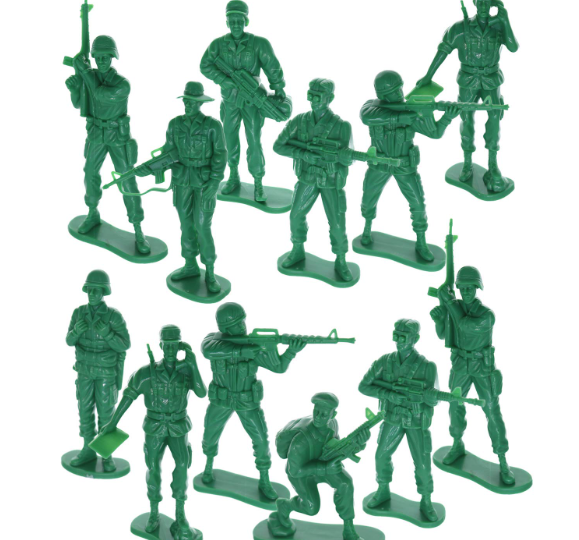
Green toy soldiers are typically produced using injection molding, not thermoforming. Here’s why injection molding is the preferred method for manufacturing these small plastic figures:
Injection Molding for Green Toy Soldiers
1. Detail and Precision
- Complex Shapes: Injection molding allows for the creation of highly detailed and intricate shapes, which is essential for replicating the fine details of toy soldiers, such as facial features, uniforms, and weaponry.
- High Precision: The process produces parts with tight tolerances, ensuring that each soldier has consistent detail and quality.
2. Material and Durability
- Plastic Materials: Common plastics used include polystyrene (PS) or polyethylene (PE), which provide the right balance of strength and flexibility.
- Durability: Injection-molded figures are durable and can withstand rough play, making them ideal for children’s toys.
[elementor-template id=”4330″]
3. Efficiency and Cost-Effectiveness
- High Volume Production: Injection molding is highly efficient for mass production. Once the mold is created, it can be used to produce thousands of identical figures quickly and cost-effectively.
- Economies of Scale: The cost per unit decreases significantly with large production runs, making it an economical choice for producing large quantities of toy soldiers.
4. Consistency
- Uniformity: Injection molding ensures that each toy soldier is uniform in size, shape, and detail, which is important for collectible sets and consistent quality.
Why Thermoforming is Not Used
1. Suitability for Shapes
- Simple Shapes: Thermoforming is generally used for producing items with simpler shapes and thinner walls, such as packaging, trays, and disposable cups. It is less suitable for creating the detailed and complex shapes required for toy soldiers.
- Thin Walls: Thermoformed products often have thinner walls, which might not provide the necessary durability for toy soldiers.
2. Detailing and Precision
- Lower Detail: Thermoforming does not offer the same level of detail and precision as injection molding. The process involves heating a plastic sheet and forming it over a mold, which is less precise than injecting molten plastic into a detailed mold.
[elementor-template id=”4331″]
Conclusion
Green toy soldiers are injection molded to achieve the necessary detail, precision, durability, and cost-effectiveness required for these small, intricate toys. Injection molding allows for the production of highly detailed figures with consistent quality, making it the ideal manufacturing process for toy soldiers. Thermoforming, on the other hand, is not suitable for producing such detailed and complex shapes.
Related Conten: Injection Mold Manufacturing
 DTG Mould Trade Process |
|
| Quote: | According to sample, drawing and specific requirement. |
|---|---|
| Discussion | Mold material, cavity number, price, runner, payment, etc. |
| S/C Signature | Approval for all the items. |
| Advance | Pay 50% by T/T |
| Product Design Checking | We check the product design. If some position is not perfect, or can not be done on the mould, we will send customer the report. |
| Mold Processing | Send report to customer once each week |
| Mold Testing | Send trial samples and try-out report to customer for confirmation |
| Mold Modification | According to customer’s feedback. |
| Balance Settlement | 50% by T/T after the customer approved the trial sample and mould quality. |
| Delivery | Delivery by sea or air. The forwarder can be designated by your side. |
 |
|

